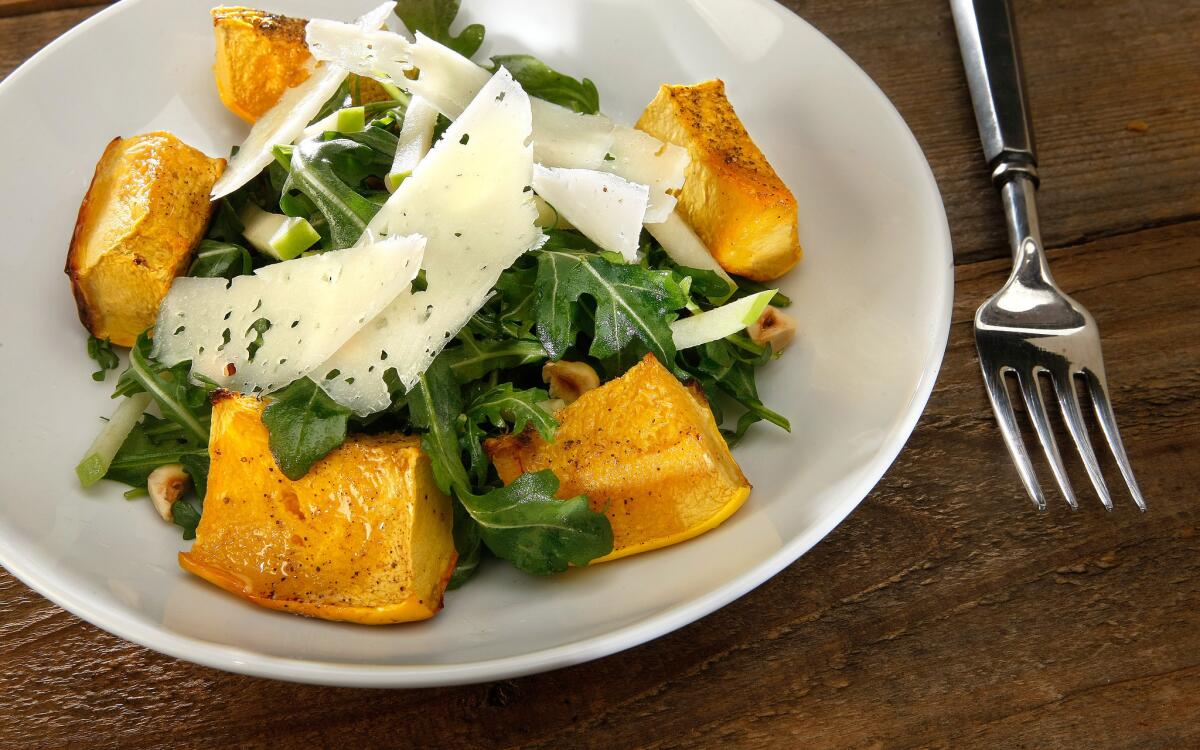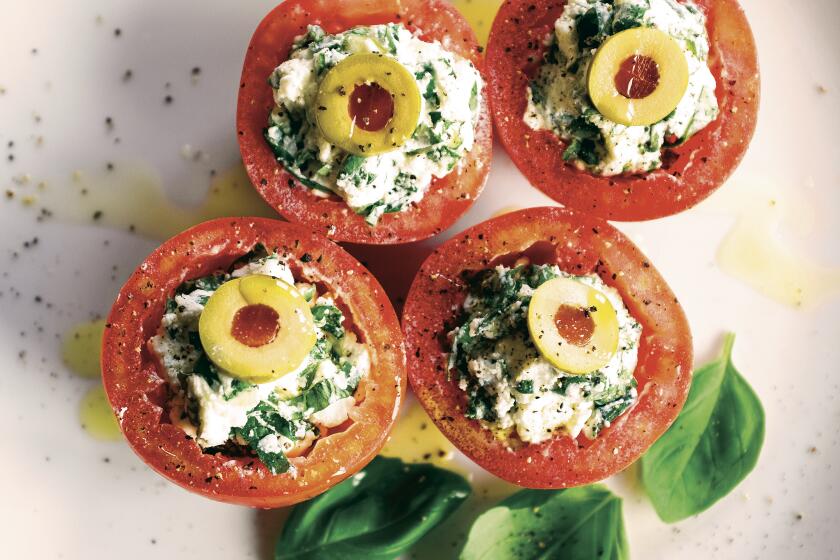Roasted acorn squash and apple salad

- Share via
It’s ironic, in a rosemary-infused sort of way, that in today’s farm-to-table restaurant era few chef-and-farmer relationships have evolved into the true collaborations those farm-specific menus often suggest. Their lives tend to exist in parallel worlds, firmly rooted together but never quite merging.
Like many farmers, Bill and Barbara Spencer of Windrose Farm have long focused their energy on the growing needs of their produce, such as Ashmead’s Kernel and Hudson Golden Gem apples, on their 70-acre farm just outside Paso Robles. Their chef customers, including David Sundeen Jr., 36, and his wife, Susan Dumeyer, 40, have made all of the apple-inspired culinary decisions.
But what if, for an entire year, those chefs were farmers? Not as pickers, though Sundeen and Dumeyer did plenty of apple hauling during those 12-hour workdays on Windrose Farm. Nor as chefs-in-residence, even if the couple’s cooking leans toward apple cobbler-type fare. But as the farm’s new managers.
“Bill and Barbara were at a point they needed help tightening their focus,” recalls Dumeyer of their somewhat fortuitous arrival at the farm last January. “There are so many parallels, business-wise, between a farm and restaurant operations that often people on both sides don’t see.”
The chefs knew the Spencers from their former restaurant days when Dumeyer worked the pastry line at Grace and Sundeen was sous-chef at Govind Armstrong’s former West Hollywood restaurant Table 8 (and later executive chef at Bouchon in Santa Barbara).
When Barbara Spencer bumped into the couple at the farmers market, she invited them up for a dinner. “We got to talking about the farm, but things really evolved over several months ... we called it dating,” Barbara says, joking.
During the year of working at Windrose, Sundeen and Dumeyer developed an encyclopedic knowledge of the flavor profile of each of the 40 apple varieties grown on the farm -- knowledge, it turns out, that chefs making the buying rounds at the Santa Monica farmers market craved. More important for everyone at the table, the Spencers, both in their 60s, learned to manage their farm more like an executive chef might run a professional kitchen, and that changed their future crop outlook in the process.
“It became more about seeing how far we, as chefs, could push the envelope and really be involved in a farm,” Dumeyer recalls.
--
A welcome break
For the Spencers, Sundeen and Dumeyer’s presence afforded them an opportunity to focus on neglected projects. “After 20 years of plugging away, having two people come on and give us a break allowed Bill to really take a long-term look at the farm,” Barbara Spencer says. He now had the time to meet with contractors about adding solar power and a new produce washing station to the farm.
In the process, the Spencers also got a farm management wake-up call from Sundeen and Dumeyer. “We’re the sort of farmers who love farming, which means I’ve had a terrible habit of planting whatever I feel like,” says Barbara, an L.A.-based studio musician before buying the farmland in 1990. “That doesn’t work so well when chefs call to say they want more tatsoi greens but I only planted one row.”
It took Sundeen and Dumeyer’s arrival to instill what both couples now refer to as “a sense of urgency” on the farm. Previously, Barbara says she picked produce as she pleased rather than considering whether picking, say, the herbs or lettuces first would maximize produce washing and packing efficiency.
They applied those same kitchen management principles to the farm’s staff. “If you’ve got a guy with a real talent for pruning apples, you need to maximize your staff’s talent and put him in that job,” Dumeyer says.
The former pastry chef also created an inventory spreadsheet to track the net profit of each type of produce from seed packet to sale, including the costly labor hours, yield and sales volume. If that Tuscan kale had an incredible flavor but wasn’t profitable, it had to be replaced.
“A lot of farmers think they need more product diversity, but like at a restaurant, at some point you need to scale back from 10 [items] and produce only two for volume and quality,” Dumeyer says.
During their farm tenure, she estimates the number of regular customers quadrupled to more than three dozen restaurants, each buying substantially more produce than before.
--
Increased profits
Tracking profitability radish by radish helped improve the farm’s bottom line, but the surge in steady customers wasn’t a simple matter of cost accounting. When Sundeen started accompanying Barbara Spencer to the Wednesday Santa Monica market, it was clear he had a knack for building customer relationships with the people he knew best.
“The public buys a pound of potatoes; a chef buys 40 pounds,” Bill says. “We needed David to remind us that we have to focus on our wholesale customers to survive. He always said that we needed to be the main course on the menu, not the weekly special, as we had in the past.”
It was with that main-course motto in mind that Sundeen approached restaurant customers from the perspective of a chef turned farmer. One week he would bring a few tiny, freshly dug radishes just for David Feau, executive chef at the Royce, Pasadena’s current crown jewel of fine dining, to taste. “He’s a French chef, they love that small vegetable thing,” Sundeen says matter-of-factly. His hunch that Feau would place an order for the raspberry-sized radishes for the following week was right.
For other chefs, Sundeen regularly offered the farm’s new apple varieties for tasting as he handed over invoices for their pre-ordered produce. Each came with Sundeen’s advice on how best to cook that Red Gold or Bramley Seedling. “When you’ve got so many varieties of apples that you’re taking to the market, there’s no way chefs can keep up anymore with what [apple] they need to use,” Sundeen says.
From now on, though, it will be up to the Spencers to explain those subtle flavor variations. The chefs left the farm a few weeks ago when Sundeen was recruited to revamp Dutchman’s Seafood House in nearby Morro Bay.
But the couple isn’t leaving without a few insights of their own. “You always have to be training people in kitchens, and you can’t get frustrated with them,” Dumeyer says. “But we really discovered from Bill and Barbara how to appreciate the people who work for us.
“That, and we learned that farming is hard work,” she continues. “We both lost a lot of weight last year.”
Heat the oven to 425 degrees.
Roast the squash: Lightly coat the squash segments with a cooking oil and season with salt and pepper. Place on a sheet tray skin-side down. Bake until cooked but still firm, about 15 to 30 minutes, depending on the size of the wedges. Cool slightly before assembling the salad.
Meanwhile, make the vinaigrette: In a medium, sealable container, combine the vinegar, grapeseed oil, 1 teaspoon salt and one-half teaspoon pepper. Seal the container and shake to emulsify the vinaigrette. Taste and adjust the seasonings and flavoring as desired. This will probably make more vinaigrette than is needed; the vinaigrette will keep, covered and refrigerated, up to 1 week.
To prepare the apples, julienne them using a knife or mandoline. Toss the apples with the lemon juice to keep them from browning.
Place the greens in a large bowl with the hazelnuts and apples. Drizzle a bit of the vinaigrette over and toss until coated, adding more as needed. Season to taste with salt and pepper.
Place the dressed greens in individual bowls and place segments of the roasted squash alongside. Drizzle a little dressing on the squash. Using a potato peeler, shave strips of cheese on top of the salad and serve.
Get our Cooking newsletter
Get a taste of Los Angeles — and the world — with recipes and kitchen tricks from the L.A. Times’ Cooking newsletter.
You may occasionally receive promotional content from the Los Angeles Times.















